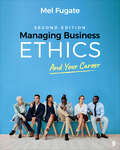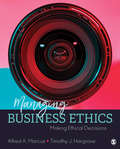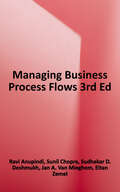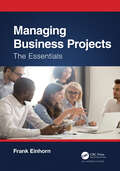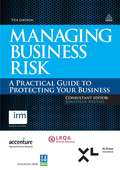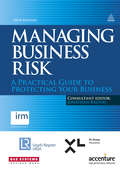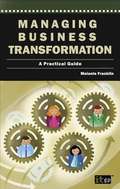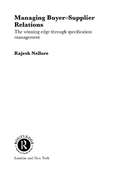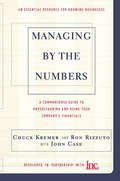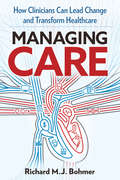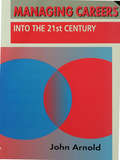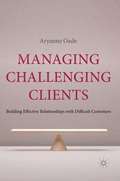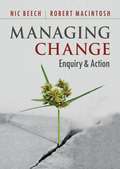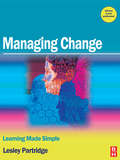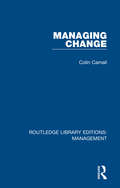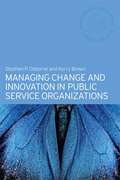- Table View
- List View
Managing Business Ethics: And Your Career
by Mel FugateFormerly published by Chicago Business Press, now published by Sage Using an applied and practical approach, Managing Business Ethics: And Your Career, Second Edition focuses on the implications of business ethics on students′ careers and the organizations where they will work. Author Mel Fugate′s conversational tone makes his coverage of concise philosophical and historical foundations of ethics, influential research, and real-world examples approachable for classroom discussion.
Managing Business Ethics: Making Ethical Decisions
by Alfred A. Marcus Timothy J. HargraveManaging Business Ethics: Making Ethical Decisions teaches students how to navigate ethical issues they will encounter using the weight-of-reasons approach applied throughout the book. This decision-making framework’s goal is not to faithfully apply particular philosophical perspectives on what is right, but rather to solve ethical problems. The authors underscore the need for employees at all levels to carefully consider the ethical implications of their actions using this approach and it can be applied at the individual, organizational, and stakeholder levels. Chapters provide a case to walk through application of the framework and mini-cases allow students to practice applying this framework on their own. A wide range of real-world case studies are presented, featuring companies such as Facebook, Google, Wells Fargo, Volkswagen, and Amazon. This practical, down-to-earth text also delves into topics not covered extensively by other books such as slow and fast thinking, the inherent conflict between the individual and organization, conformity, and the difficulties of speaking truth to power. Students are offered ample opportunity to engage in thoughtful reflection, discussion, and application as they grapple with ethical issues big and small. Included with this title: The password-protected Instructor Resource Site (formally known as SAGE Edge) offers access to all text-specific resources, including a test bank and editable, chapter-specific PowerPoint® slides.
Managing Business Ethics: Making Ethical Decisions
by Alfred A. Marcus Timothy J. HargraveManaging Business Ethics: Making Ethical Decisions teaches students how to navigate ethical issues they will encounter using the weight-of-reasons approach applied throughout the book. This decision-making framework’s goal is not to faithfully apply particular philosophical perspectives on what is right, but rather to solve ethical problems. The authors underscore the need for employees at all levels to carefully consider the ethical implications of their actions using this approach and it can be applied at the individual, organizational, and stakeholder levels. Chapters provide a case to walk through application of the framework and mini-cases allow students to practice applying this framework on their own. A wide range of real-world case studies are presented, featuring companies such as Facebook, Google, Wells Fargo, Volkswagen, and Amazon. This practical, down-to-earth text also delves into topics not covered extensively by other books such as slow and fast thinking, the inherent conflict between the individual and organization, conformity, and the difficulties of speaking truth to power. Students are offered ample opportunity to engage in thoughtful reflection, discussion, and application as they grapple with ethical issues big and small. Included with this title: The password-protected Instructor Resource Site (formally known as SAGE Edge) offers access to all text-specific resources, including a test bank and editable, chapter-specific PowerPoint® slides.
Managing Business Ethics: Straight Talk about How to Do It Right (Seventh Edition)
by Katherine A. Nelson Linda Klebe TrevinoThroughout, the emphasis is on common, real-life work situations, including hiring, managing, assessing performance, disciplining, firing, and providing incentives for staff, as well as producing quality products and services, and dealing effectively and fairly with customers, vendors, and other stakeholders.
Managing Business Family Dynasties: Between Family, Organisation, and Network (Management for Professionals)
by Tom A. Rüsen Heiko Kleve Arist von SchlippeThis book deals with dynastic business families. Such families are characterized by a circle of owners comprising more than 50 family members, which typically face specific issues and challenges for which there has been little research knowledge and practical approaches until now. The book presents results and findings from a special research project on “big family management” where 7 representatives of dynastic families from Germany were studied over a 3-year period. The result was the identification of six topic areas that management in these business families has to deal with. At the same time, the study observes that dynastic business families hardly follow the logic of classic families anymore, but can rather be understood as networks with common family backgrounds. The study also reveals that a large number of business families are heading for large shareholder groups due to changed inheritance practices. The contents outlined here provide an orientation framework for the growing business family.
Managing Business Performance
by Umit S. BititciMotivate, engage, and achieve lasting success with more effective performance management Managing Business Performance offers a unique blueprint for achieving organisational excellence through improved productivity, efficiency, engagement, and morale. With a unique approach that acknowledges the human aspect of performance management, this book combines technical and social know-how to give you a solid framework for designing, configuring, and managing performance improvement initiatives with sustainable results. You′ll find practical models, techniques, and tools that take you beyond management theory into advice that you can use, with clear explanations that steer you toward the customisations that would best suit your organisation. International case studies illustrate these ideas in action, providing an intimate look at how cultural differences impact management strategies, and insight into how they can be managed. Organisational performance tools and techniques are well established, but many organisations will never realise their full benefit. This book helps you get more out of your performance strategy by showing you how the organisation′s complex social nature impacts real-world outcomes, and how it can be used to drive better performance. Blend technical and social management strategies Keep people motivated and engaged See better results with more staying power Get the very best from your organisation Performance management strategies that fail to take people into account are counterproductive. There′s no better way to de-motivate, demoralise, and disengage the people upon whom the organisation depends. Sustainable success requires a blended approach that utilizes the most effective science within the art of people management, and Managing Business Performance gives you a solid foundation for better business performance strategy.
Managing Business Process Flows
by Ravi Anupindi Sunil Chopra Jan A. Van Mieghem Eitan Zemel Sudhakar D. DeshmukhA structured, data-driven approach to understanding core operations management concepts. Anupindi shows how managers can design and manage process structure and process drivers to improve the performance of any business process. <p><p>The third edition retains the general process view paradigm while providing a sharper, more streamlined presentation of the development of ideas in each chapter-all of which are illustrated with contemporary examples from practice.
Managing Business Projects: The Essentials
by Frank EinhornManaging Business Projects: The Essentials differs from many other project management textbooks. Foremost, it is about business projects as opposed to construction or engineering projects. Although many techniques, like schedule management, apply to both, they are usually applied differently. As its title conveys, the book explains the essential techniques and perspectives needed for business projects to be successful. The focus is on small and medium sized projects, up to $20 million, but often below $1 million. Some literature favors large and mega-projects, but for every mega-project there are many thousands of smaller projects which are vital to the organization and could involve considerable complexity and risk. Nevertheless, the techniques outlined here also apply to mega-projects and their many subprojects; they even apply to some aspects of construction or engineering projects. This book does not aim to cover all project management techniques. In real life there is simply not time for sophisticated ‘should-dos.' Rather, it covers the essentials that apply to almost all business projects; these are unlikely to change in the future even as technology and methodologies advance. The driving idea, which is stated repeatedly, is to do the essentials and to do them consistently and well. Strong emphasis is placed on things that happen before, around, and after the project itself. So, while the basic disciplines like engaging with stakeholders, managing scope, schedules, costs, risks, issues, changes, and communication, are thoroughly explained, other important aspects are covered. These include: governance of a project and of a portfolio of projects, project selection with its financial and non-financial aspects, effective use of the business case through to benefits realization, procurement, outsourcing and partnership, and also the agile mindset that is valuable beyond Agile projects. Besides project managers and sponsors, this book is intended for people who are working in business or government, at any level, or for MBA students. It offers perspectives that enable them to learn more from their everyday experience. It is not aimed at undergraduate students, although many would benefit from the contents.
Managing Business Risk
by Jonathan ReuvidEffective risk management - the identification, assessment and prioritization of risks - is a vital consideration when looking to safeguard your company's commercial future and deal with the latest regulatory requirements. Managing Business Risk will enable your company to maintain controls on risks that may threaten your business while at the same time delivering transparent reporting to your stakeholders. The book examines the key areas of risk in today's competitive and complex business market. Drawing on expert advice from leading risk consultants, lawyers and regulatory authorities, it shows you how to protect your business against a rising tide of business risks. If you don't build risk controls into the structure of your company, from the boardroom down, then your business could be vulnerable to a number of threats - both internal and external. Identify and neutralise them now, and give your company a competitive advantage.
Managing Business Risk
by Jonathan ReuvidEffective risk management - the identification, assessment and prioritization of risks - is a vital consideration when looking to safeguard your company's commercial future and deal with the latest regulatory requirements. Managing Business Risk will enable your company to maintain controls on risks that may threaten your business while at the same time delivering transparent reporting to your stakeholders. The book examines the key areas of risk in today's competitive and complex business market. Drawing on expert advice from leading risk consultants, lawyers and regulatory authorities, it shows you how to protect your business against a rising tide of risks. If you don't build risk controls into the structure of your company, from the boardroom down, then your business could be vulnerable to a number of threats - both internal and external. Identify and neutralise them now, and give your company a competitive advantage.
Managing Business Transformation
by Melanie FranklinChange can bring improved efficiency, increased productivity and greater profitability. An effective manager knows how to identify and implement improvements. But how do you identify the changes that will benefit your business, and how do you implement them? In Managing Business Transformation: A Practical Guide, Melanie Franklin will guide you through all the stages of change management. Using real-life examples, up-to-date information and clear diagrams, this practical handbook will equip you to be an agent of change, whatever your role. Your stakeholders are a vital asset, and communicating changes to them in a way that will retain their loyalty and commitment is crucial. This book will show you how to do this, recognising that some embrace change more readily than others, and will provide strategies for dealing with resistance to change. You will also understand the differences between change management and project management, the relationship between them and how to make them work for you. This book will enable you to understand, plan and prepare for change, to create a change plan and to communicate it to your staff, and to implement and embed the change. Your new business as usual will run more smoothly and be more profitable Melanie Franklin has an extensive track record in the realisation of business change programmes within the public and private sectors. She is the founder and Chief Executive of Maven Training, and balances her company responsibilities with her interest in helping organisations to make changes that deliver their strategic objectives.
Managing Buyer-Supplier Relations: The Winning Edge Through Specification Management (Routledge Studies In Business Organizations And Networks Ser.)
by Rajesh NelloreManaging suppliers is a complex process that is often underestimated. This book presents research carried out by a practising manager in the automotive industry, coupled with over six hundred interviews with representatives from the automotive, aircraft and white goods industries, in order to describe the tools and techniques needed to better manag
Managing By The Numbers: A Commonsense Guide To Understanding And Using Your Company's Financials
by John Case Chuck Kremer Ron RizzutoEveryone interested in building a stronger business needs to understand and use the information captured in financial statements. In Managing by the Numbers, business education and accounting experts Chuck Kremer and Ron Rizzuto team up with open-book management authority John Case to demystify the numbers. They present a practical, common-sense approach to reading financial statements and to managing the three bottom lines of business financial performance: net profit, operating cash flow, and return on assets. The book features numerous exercises and examples (with associated templates available on the Web), a powerful new management tool known as "The Financial Scoreboard,” and an extensive glossary. Managing by the Numbers is an essential resource for entrepreneurs, business owners, managers, and anyone eager to improve their mastery of the financial side of running a business.
Managing Care: How Clinicians Can Lead Change and Transform Healthcare
by Richard BohmerHealthcare systems worldwide are swamped with demand, short of resources, and ill-equipped to respond to global health crises like COVID-19. This book is a guide for reforming healthcare delivery. The way we organize care matters, and the people best positioned to drive this are the clinicians who deliver care. The book offers a framework for transforming healthcare delivery that covers operational design, change management, long-term learning, and organizational environment. It describes the work of leading local operational change; identifies key decisions to be made, actions to be taken, and factors that must be taken into account; and gives clinicians the tools and perspectives they need to lead change.The challenge of modern healthcare is to develop better organizations capable of delivering compassionate and individualized care on a grand scale while preserving the personal relationship between clinician and patient and the quality of care at the ward, operating room, clinic, or practice. Informed by extensive research and experience with systems all over the world, Richard Bohmer shows how organizations may transform by deploying a new workforce of clinical change leaders and how clinicians can take greater control over their own working environments.
Managing Careers and Employability
by Yehuda BaruchCombining a strong theoretical underpinning with a wide range of case studies and practical examples, this authoritative textbook provides a deep understanding of career systems, on both an individual and an organizational level. Taking a global approach, Managing Careers and Employability looks at recent labour market developments and explores contemporary topics such as entrepreneurial careers, career ecosystems and the dark side of careers. A wide range of learning features including reflective questions, key terms and exercises, empower you to reflect on and manage your own career. Online resources include a Tutor’s Guide, containing teaching notes for each chapter, as well as PowerPoint slides that can be adapted and edited to suit specific teaching needs. Suitable for undergraduate and postgraduate students studying career management and related courses. Yehuda Baruch is Professor of Management at Southampton Business School, the University of Southampton.
Managing Careers and Employability
by Yehuda BaruchCombining a strong theoretical underpinning with a wide range of case studies and practical examples, this authoritative textbook provides a deep understanding of career systems, on both an individual and an organizational level. Taking a global approach, Managing Careers and Employability looks at recent labour market developments and explores contemporary topics such as entrepreneurial careers, career ecosystems and the dark side of careers. A wide range of learning features including reflective questions, key terms and exercises, empower you to reflect on and manage your own career. Online resources include a Tutor’s Guide, containing teaching notes for each chapter, as well as PowerPoint slides that can be adapted and edited to suit specific teaching needs. Suitable for undergraduate and postgraduate students studying career management and related courses. Yehuda Baruch is Professor of Management at Southampton Business School, the University of Southampton.
Managing Careers into the 21st Century (Career Development Ser.)
by John Arnold` John Arnold has written a book which will serve well any student or new practitioner in the area of career management, both in terms of explaining how thinking has developed, and in looking forward to the complexities of the future' - Career Path, Institute Personnel and Development `This book has two purposes for education leaders. It provides understanding of the world of pupils will be moving into. More urgently, because it is not yet sufficiently recognised, it provides a framework for us to consider what is happening to teachers' careers now' - School Leadership The book will appeal to several different audiences, particularly those taking human resource modules in MBA and other postgraduate management courses, undergraduates taking special modules in university business schools or psychology departments, and all practising human resource managers, particularly those concerned with career management and (in the UK) those taking the IPD option on career management. The book is not primarily a do-it-yourself career manual, but nevertheless contains much that will assist people to manage their own careers better.
Managing Challenging Clients
by Aryanne OadeDo you need to deliver an effective service to challenging and, at times, unreasonable internal or externa clients? Do you worry that you'll lose business, or suffer damage to your reputation, if you don't handle a particular customer well enough? Do you need to improve the quality of your relationships with your clients in order to secure more repeat and long-term business or to avoid your function being out-sourced? Perhaps you want to know how to handle ambivalent and oppositional client personalities. Perhaps you want to become more skilful at handling customers who appear, at times, obstructive to the work they have asked you to do. Or perhaps you simply want to understand how to work more effectively with clients who are, in the main, troublesome and challenging from your first contact with them onwards. If so, this book is for you. Managing Challenging Clients takes you through a highly practical, personal and insightful process. It will introduce you to a valuable set of tools which will enable you to assess how you go about building, maintaining and managing your client-facing relationships. The book will help you to improve the level of influence you achieve with awkward and challenging clients whether they work for your organization or another employer. Managing Challenging Clients will help you to: Understand how to create and maintain influential, value-added relationships with the most difficult of customers. Recognise where your responsibilities to your clients begin and end. Identify the risks some clients perceive that they face when they place their trust and reputation in your hands. Understand the importance of the interconnected issues of trust, control and involvement to the quality of dialogue you establish with your customers. Extend the range of influencing options available to you when working with your most controlling, manipulative or unreasonable clients. Assess at what point to cease working with a particularly challenging client. Get the best chance of delivering a service which is perceived as value-added even when handling an unreasonable situation and a provoking character. "
Managing Change
by Nic Beech Robert MacintoshThe ability to manage change successfully is an essential part of business. It is a skill that is much valued by employers, and it is therefore one of the most commonly delivered courses. This book helps you to understand three key activities for managing change: diagnosing, explaining and enacting. Both practical and action-oriented, it gives students and managers the tools they need to deal with the messy reality of change. It combines theory and diagnostic tools with practical examples that focus on actions and outcomes. It also includes short vignettes and longer cases, from a range of international contexts, for classroom study or for use on distance learning courses. Managing Change is written for advanced undergraduates and graduate students taking modules on change management, strategy and organizations. Its class-tested approach has been successfully delivered in a wide variety of settings, including over fifty executive short courses with FTSE-listed businesses.
Managing Change (Learning Made Simple Ser.)
by Lesley PartridgeLearning Made Simple books give you skills without frills. They are matched to the main qualifications and written by experienced teachers and authors to make often tricky subjects simple to learn. Every book is designed carefully to provide bite-sized lessons matched to readers' needs.Using full colour throughout and written by leading teachers and writers, Learning Made Simple books build on a rich legacy of over 50 years as leading publishers helping to learn new skills and develop their talents.Whether studying at college, training at work, or reading at home, aiming for a qualification or simply getting up to speed, Learning Made Simple Books will give readers the advantage of easy, well-organized training materials in a handy volume you can refer to again and again. These titles will be promoted direct to training companies and learners, and individuals will be urged to buy them not only by college lecturers but also by trainers at work. These titles will be core stock for years to come.The books are written by experienced HR trainers and will be typeset by PK McBride (an experienced teacher and author of several Learning Made Simples himself). PK McBride has a thorough understanding of the ethos of the LMSs books and his involvement will insure that all titles have a layout and style consistent with the brand. Lesley Partridge has 18 years' experience in the writing, design and development of learning materials aimed at the management and people development market. Lesly trained in educational publishing with Jossey-Bass, Wadsworth, and the University of Claifornia at Berkley Press in the US. Her clients have included ScottishPower, BSkyB, British Gas, Crown Prosecution Service, RNIB and the BBC.
Managing Change (Routledge Library Editions: Management #21)
by Colin CarnallThe purpose of this book, originally published in 1991, is to provide managers with a practical approach to planning and managing significant changes. It will help them to determine the objectives, scope and direction of change and to formulate a structured implementation plan. Managers will learn how to identify and measure the skills needed to handle changes and to define activities that will develop those skills. The workbook incorporates self-assessment exercises, company assessment exercises, and a case-study. This title will be of interest to students of economics, management, and business studies.
Managing Change / Changing Managers
by Julian RandallThe topic of change management presents students with many challenges. One of the most difficult is making sense of the plethora of guru and hero-manager literature.Managing Change/Changing Managers is an innovative textbook that encourages readers to rigorously question popular management theory, presenting a challenging review of existing literature in the change management field. The author brings together an overarching perspective on the most influential writings in the area, but unlike other textbooks, provides a much-needed criritque of the material and its implications for management practice.Arguing that the majority of management guru literature makes the art of managing change appear simple and foolproof when it is not, this text is refreshingly critical, guiding and enhancing the reader's own criticality. The book also draws the best practice out of the traditional theory, using cases to illuminate the practical side to change management.
Managing Change Effectively: Approaches, Methods, And Case Examples
by Donald L. KirkpatrickOne of the most important skills of successful managers is dealing with change. 'Managing Change Effectively' combines philosophical insights with practical applications to help managers effectively incorporate change with the least disruption. 'Managing Change Effectively' details specific approaches and methods for making change decisions and getting changes accepted. From communication to participation, Kirkpatrick shows managers and executives how to make change their ally. Packed with examples that illustrate the principles and procedures for implementing new ideas, policies and strategies for almost any type of organization, this text is a valuable resource for managers at all levels, especially those in training and human resources.
Managing Change and Innovation in Public Service Organizations (Masters in Public Management)
by Kerry Brown Stephen P. OsborneThe context and environment of public services is becoming increasingly complex and the management of change and innovation is now a core task for the successful public manager. This text aims to provide its readers with the skills necessary to understand, manage and sustain change and innovation in public service organizations. Key features include: the use of figures, tables and boxes to highlight ideas and concepts of central importance a dedicated case study to serve as a focus for discussion and learning, and to marry theory with practice clear learning objectives for each chapter with suggestions for further reading.Providing future and current public managers with the understanding and skills required to manage change and innovation, this groundbreaking text is essential reading for all those studying public management, public administration and public policy.
Managing Change and Transition
by Harvard Business School PressHarvard Business Essentials are comprehensive, solution-oriented paperbacks for business readers of all levels of experience. Managing through change and crisis is difficult in any business environment, let alone one as turbulent as managers face today. This timely guide offers authoritative advice on how to recognize the need for organizational change, communicate the vision, prepare for structural change such as M&A, and address emotional responses to downsizing. With tools for managing stress levels and advice on gathering and sharing information during a transition, Managing Change and Transition is an indispensable guide for managers at any level of the organization.
